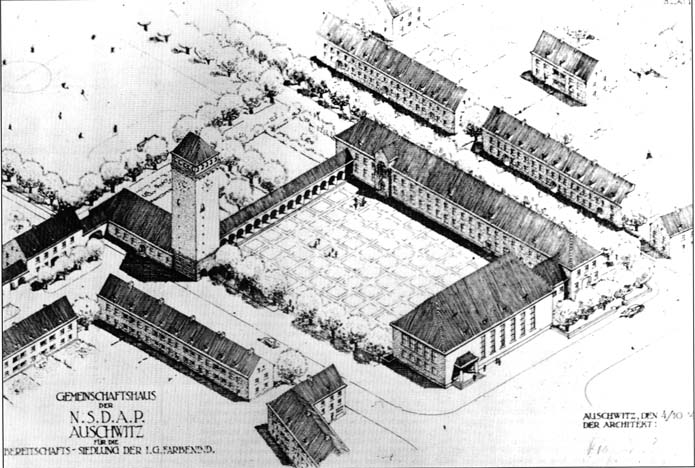|
|
 |
 |
AUSCHWITZ:
Technique
and Operation
of
the Gas Chambers © | |
|
| |
 |
Back |
 |
Contents |
Page 529 |
 |
Home
Page |
Forward |
 |
| |
A considerable part of the industrial program for the
Auschwitz region was actually implemented, because this was
essential to the war effort. On the other hand, the more "esthetic"
development of the concentration camp and the SS colony was not
realized, halted by the extermination of the Jews and relegated to
the lowest of the economic priorities of the moment. Despite the
lack of written documents, the overall picture of the SS
colonisation of Oswiecim can be clearly seen thanks to the remaining
drawings [see documents]. In order to translate their view of the
world, the SS in fact preferred plans and drawings to written
documents. The size and importance of the "Bauleitungen" and their
drawing offices is eloquent in this regard. Drawings made it
possible to represent their ideas in concrete form, providing
precise representations comprehensible to all, whereas written
documents, even very detailed, still leave room for personal
interpretation and a certain fuzziness and can never produce results
as clear and reproducible as drawings.
Knowing what the
SS planned for the Auschwitz region, one may ask: |
| |
| 1. |
Whether it would have been
materially possible to realize the projects, in particular the
buildings for the SS and the organization of the whole town on the
lines of a luxurious barracks. If the war had turned in favour of
the Axis powers in 1942 and been won quickly, the buildings could
have been constructed and finished at the price of stepping up the
concentration camp system, but using the prison labour more
"sparingly", which would have meant the end of the earlier system of
a "three months of slave labor and afterwards the chimney!"
Initially. Hoess, the first Camp Commandant of Auschwitz was very
much in favour of this solution (no doubt mainly on the grounds of
efficiency), but his efforts were in vain first of all because the
other SS did not see it his way, having instituted a system of
ill-treating the prisoners, and then because it became impracticable
because of the senseless orders he received and the pressure of the
general situation. |
| 2. |
What social progress did the SS
offer with their model colony? The answer is disquieting: a return
to the social order of a thousand years ago, through the
establishment of a neo-feudal society with an SS aristocracy, new
knights in shining (motorized) armour, reigning over their serfs:
prisoners and others of lowly status. The stresses engendered by
such a society would be so strong that they would sooner or later
have become explosive. Modern day "peasant revolts" would have
broken out, and the system, always in a state of latent crisis,
would have broken down, undermined from within. The SS vision of the
future was simply utopian. |
| |
| Other attempts have been made to analyze what would
have happened to a Germany that had won the Second World War, and in
these the position of the SS would have been dominant. Albert Speer
outlines the prospects in his “Der Sklavenstaat” (The slave state].
The “colonization” of the east, defined essentially as a programme
of major works and huge constructions, would have cost the lives,
according to Speer's calculations, of 29 million prisoners, being
literally worked to death in “SS construction brigades”, each made
up of 4.800 men in 24 companies. These men would have been supplied
by the concentration camps. The "Ostraum / Eastern area" would have
become a colonization area, criss-crossed by motorways, with towns
of 15 to 20,000 people located at the major intersections,
surrounded by a purely |
|
 |
| |
Document 13:
[PMO neg. no. 20589] |
|
| |
|
|
| |
Gemeinnchafthaus der NSDAP
Auschwitz für die Bereitschafts-Siedlung dar IG Farbenind.
/
Auschwitz NSDAP / [Nazi Party] community center for the IG
Farbenindustrie workers’ district
Blatt Nr. VI/Sheet No VI J
Auschwitz 4/10/41
The Architect (unknown signature)
|
| |
| |
AUSCHWITZ:
Technique
and operation
of the gas chambers
Jean-Claude Pressac
© 1989, The
Beate Klarsfeld Foundation |
 |
Back |
Page 529 |
Forward |
 |
|

